Nancy Rubins
After the visit at the gagosian Gallery, I was struck by Nancy Rubins work. I like the way she used animals that are meant to be outdoor to create this harmonious explosion almost like geyser in Iceland bursting out of the floor, like an explosion. The title diversifolia might show the diverse species in her explosion.
I think what was very effective in the gallery was the way the artwork functionate with the white and grey floors. It created a massive contrast with the explosion
Marteen Vanden Eynde
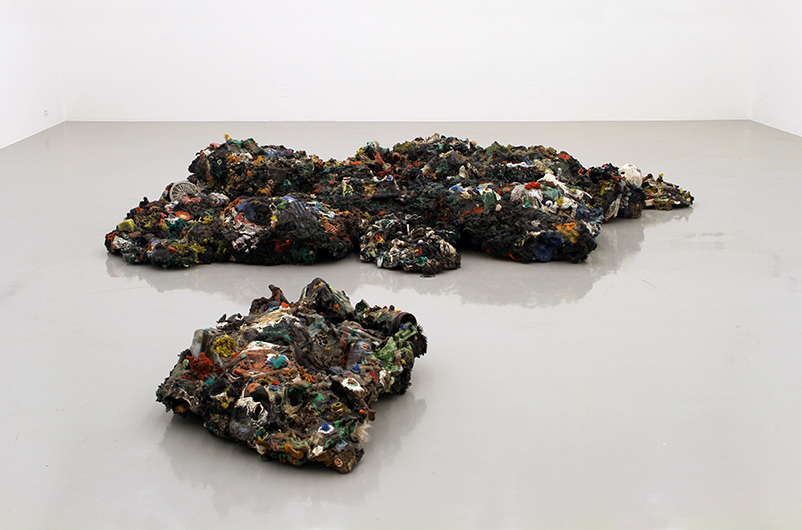

This plastic coral reef was created with all the plastic from the 7th continent which is entirely made up of plastic. The artist used two controversial poles as he created with plastic an environnement which will be destroyed by plastic as well. To me it seems like a warning, it feels related to the book 2050, where Jacque Attali warns us about the world and how polluted it might get if we don't change our habits. Maarten vanden eynde seems to tell us, this is what our corals will be replaced with if we don't stop this carnage.
It is interesting to see how the artist convey his belief through his piece and chose to create an aesthetic piece, one could think that if the artist was trying to make a political point and societal point he would use disgust to struck the minds. However you will find that the plastic coral reef is on the contrary very aesthetic. This is how i think we differenciate political speech and authors (such as jacques attali) and artist, which obviously are conveying things through their piece. And doesn't have to do it abruptely even thought they can (pussy riot/ activist russian artist Piotr Pavlensky...) because they have another role.
Since I'm very inspired by the big disscussion in brussels currently where the governement is about to ban plastic straws especially the ones under 5 milemeters diameter since they easily fit in a turtle nose. I will try to use Maarten vanden Eynde work to create my own with straws. I think it will look more like crystals but could be very beautiful and also sending a powerful message to the public.
Straw art

Gursky Iceberg/Flower?!
Cosmic effect


Microcosme- Macrocosme
Understanding abstract art Article
Understanding Abstract Art
Understanding abstract art is easy: all it requires is an open mind and a big imagination. When you look at the painting on the left, what do you see
Swirling shapes, an array of colorful patterns... The path of a flowing river cutting through fields of lush vegetation... or maybe you see pure energy and cosmic flow?
There is no right or wrong answer to this question. Abstract art is open to interpretation, and that is one of the beautiful things about it. Abstract art doesn't jump out and declare "THIS is what I'm all about." Instead, abstract art requires you to have an open, inquiring mind; you must enter the painting and see where it takes you. Abstract art gives you the freedom to explore the artwork and assign your own meaning to the piece. This intensely personal process enriches a viewer's experience of an artwork.
Understanding abstract art does not come naturally for everyone. It is the kind of art that makes some people scratch their heads and say, "My 5-year old could do that." What people don't realize is that the best abstract artists have excellent drawing skills, a finely honed sense of composition, and a deep understanding of the workings of color. Most abstract artists have the ability to draw a perfectly rendered rose or a realistic portrait, but they choose not to. Instead they choose to express their creativity by creating a visual experience that is more free and unencumbered by the weight of objects.
Abstract art can also make people uneasy because they don't automatically know what the art is "about" just by a cursory glance. Or they assume that because it doesn't look like anything, then it is not "about" anything. Abstract art doesn't contain recognizeable objects, so there is nothing to grasp or hold onto. This can be very confusing, even threatening, to some who are not used to assigning their own meaning to what they see before them.
The truth is, abstract art is not "about nothing". At its basis, it is about form, color, line, texture, pattern, composition and process. These are the formal qualities of artwork, because they describe what the art looks like and how it is created. Abstract art is an exploration of these formal qualities. Meaning is derived from how these formal qualities are used to create a visual (and/or visceral, cerebral, emotional, etc) experience.
How do you begin understanding abstract art?
“Everyone wants to understand art. Why not try to understand the song of a bird? …people who try to explain pictures are usually barking up the wrong tree.”— Pablo Picasso
Picasso has a point. Art can't be explained adequately in words, because it's influence on people is so personal and speaks to the nonverbal parts of our existence. Therefore, art is an experience. You must let go of your need to put things into words, and let the artwork take you somewhere... even lift you into higher spheres.
You have to 'understand' abstract art with a different part of you, one that you may not normally use or be familiar with. Essentially, you must:
Accept that it is what it is. Don't try to pinpoint an exact meaning for an image.
Look at abstract art in the same way that you would listen to a symphony. When you listen to music, you don't try to hold on to the notes - you let them wash over you. Let your eyes wander over the painting the way the notes of a symphony wash over your soul. Let your eyes play with the painting, slipping around corners, following the twirls, twists and turns, dipping in and out of the surface. Let your eyes dance around the piece.
Rather than trying to figure out what the painting looks like, just allow yourself to be taken in by the painting. See what emotions, sensations or memories emerge. Let your eyes relax and travel around the piece without expectation. Examine the colors, forms, materials, surface, and how they interact with each other. Take your time. Let the painting "speak" to you.
Notice how the various elements like shape, color and form affect you. An intricately detailed, vibrant painting will affect you differently than a calm, cool Malevich.
Take a look at the two artworks below. What are the differences in how they make you feel?It is best to see abstract art in person to truly get the full effect. This will help you immeasurably with understanding abstract art. You can't get the full impact of a piece of art from a small photo in a book or pixelated image online. In person, you can see up close the texture, size, stroke of the paintbrush, shine or matte of the surface. You can feel the strength of the painting from across the room. You can stand in the space the artist once occupied, and try to imagine his or her thoughts upon each stroke of the brush.
Understanding abstract art requires an inventiveness that invites you to discover for yourself the meaning behind the work. It is not easy to grasp, like still lifes, portraits, or other form of representational art, because it is open to interpretation in a way that representational art is not.
Growing alum crystals
Borax impossible to find
In the UK borax substitute is sold in department stores as a cleaning powder but not real borax, and taxidermists still regularly use borax to preserve and clean hides and feathers of mounted animals. One must be careful, however, when using borax, especially in powdered form, because its effect as an irritant is well documented. The dust of borax can cause respiratory and skin irritation if used in large amounts, so those working with borax must take care not to breathe in the powder. Some pet owners spread powered boric acid over their carpet to kill fleas, spiders and other pests, though this must be done carefully to limit the pet’s exposure as well, as many animals are also sensitive to borax.
Although the substance has been banned for consumption, there is a large group of people who believe borax isn’t harmful. Some say it even has health benefits. But for now, borax remains far away from foods, in the cleaning aisle only.
Growing Borax crystals
Crystallised books




This has been done with borax crystals, it is fascinating to see that it crystallised books and really thickly as well
Nancy Rubins press release
Opening reception:
Tuesday, February 6, 6–8PM
I am interested in the balance, the engineering and tenuousness of the objects, as well as the dynamic tension and energy. . . . A continuum starts happening with one piece attached to another . . . the way that crystals or cells grow. I’m interested in the bigger picture.
—Nancy Rubins
Gagosian is pleased to present “Diversifolia,” an exhibition of new sculpture and drawings by Nancy Rubins. This is Rubins’s first solo exhibition in London.
Rubins transforms found objects and industrial refuse into expertly orchestrated abstractions that are fluid and rhizomatic in nature. Achieving this expressive fluidity at such a large scale requires precise engineering; in her recent work, she has employed a structural property called “tensegrity,” wherein individual parts are arranged in balanced compression and secured with tensile cables. Clusters of like objects—airplane parts, boats, carousel creatures, and more—seem to explode into space in all directions, propelled by their aggregated momentum.
In the scientific names of plants, “diversifolia” indicates a single species possessed with a considerable variety of leaf. Rubins’s sculptures, though devoid of leaves per se, are bouquet-like arrangements comprised of a wide range of animal forms—giraffes, storks, tortoises, crocodiles, wolves, and hogs—cast in iron, bronze, brass, and aluminum. Though easily recognizable for their intended use in garden decor or signage, Rubins treats the sculptures as purely formal, abstracted components: limbs and tails flower-like Baroque arabesques in Hog de la Ivy (2016–17); tortoise shells create a cloud-like foundation from which rectangular bases and silvered hogs emerge; and the sharp antlers in Agrifolia Major (2017) give way to the animated curls of crocodile tails. Rubins also responds to the imperfections of the sculptural elements, their conspicuous seams and erratic welding influencing aesthetic and structural decisions such as where to place the drilled holes that allow the cables to zigzag through and bind the cantilevered components within the sculpture.
Reversing the scale relationship between sculpture and viewer, a selection of smaller maquettes cast in bronze and aluminum allow Rubins’s calculated compositional decisions to be observed all at once, impossible when circumnavigating the towering assemblages. From the sprawling sculptures to the large-scale graphite drawings—burnished swathes of paper undulating from the walls—Rubins suggests an endless continuum between the chaos and coolness of modernism and the élan vital of the organic.
In spring 2018, Monochrome II, a permanent outdoor sculpture, will be installed at Crystal Bridges Museum of American Art, Bentonville, AK.
Nancy Rubins Gagosian Gallery
This work by Nancy Rubins, inspired me. I liked how she creates this explosion of animals, music and other elements. And they are all tied up together. The works looks like an explosion coming from a geyser (island), lots of things bursting out of the grounds, or more sinic it reminds me of a bomb. Once the bomb is dropped all the living organisms jumps!
Striking extract Grayson perry book
What they [artists, dealers, curators, etc] form is this lovely consensus around what is good art. I did a pot once called Lovely Consensus. I asked my dealer for the top fifty names of people and institutions where I should hope my work would end up, almost like the perfect CV, and I wrote them on to this pot in a decorative way and it was in my show for the Turner Prize, and one of the names on that pot was a very famous art collector called Dakis Joannou and he saw the pot and bought it over the phone while he was looking at it in the Tate Gallery. So that’s just as an aside, a little tip for any artist.
Roger Hiorns, Seizure Press release
n 2008, every surface of an abandoned London council flat was lined with a thick layer of glistening, knife-sharp copper-sulphate crystals – creating an angular cave that was at once alluring, sensuous and needlingly dangerous. This was Seizure, by Roger Hiorns – the British artist (or, you might think, alchemist) who once caused flames to rise from the drains of the Tate, and who is currently showing a granite altarstone, which he has pulverised to a silky dust, at the Venice Biennale.
Seizure became a cult hit. Hiorns recalls with some amazement, even now, that "it became for people a spiritual space – a place that people used to stoke their inner lives".
Seizure was an extraordinary work to make: the abandoned flat having been encased in watertight metal, 90,000 litres of heavily saturated copper sulphate solution were poured into it from an opening in the ceiling and left to react for just over a month. Then the liquid was pumped out and, said Lingwood, they all hoped they hadn't created "a glorious – or inglorious – failure". Going in for the first time, waving torches around that deathly blue, menacing interior, was like "entering Tutankhamun's tomb", he said.
It was an even more extraordinary work to remove from its host building in London and transport to Yorkshire: Caroline Douglas, head of the Arts Council collection of art, to which Hiorns has donated the work, said: "I was beside myself for two and a half years." With enormous delicacy, precision and engineering expertise, the entire flat was slid out of its parent building in tiny increments over the period of a week. "We didn't know how robust it would be," she said. "We were afraid we would end up with, in effect, a box with a heap of crystals at the bottom." The whole 31.2 tonnes of it was craned on to a truck and, after two and a half days of travelling, the wide slow load arrived in Yorkshire. "It was not the sort of truck you wanted to be stuck behind in a car," said Douglas. The removal process, funded by arts charities, cost a little over £40,000.
Roger Hiorns
Roger Hiorns work is verry impressive. As explained in the video he sunk the whole room for one month in copper sulfate. The cross boundaries between art and science have always fascinated me in several ways. This is almost chemistry, he created the most magical work and I liked the fact that his works was immersive, meaning that you could really live this out of world experience. It was like entering a giant geode, and going is some space in the universe.
Roger Hiorns

Roger Hiorns
Tokujin Yoshioka
Tyler Thrasher


I looked at another artist exploring decay and crystallisation, two oposites process, Tyler Thrasher. He used dead animals already decaying, and crystallise them partly. It is very interesting to see his work as there is a conflict between these two chemical process, and you do not know what will take over. Is it decaying? or crystallising?
Tyler thrasher
Sigalit Landeau
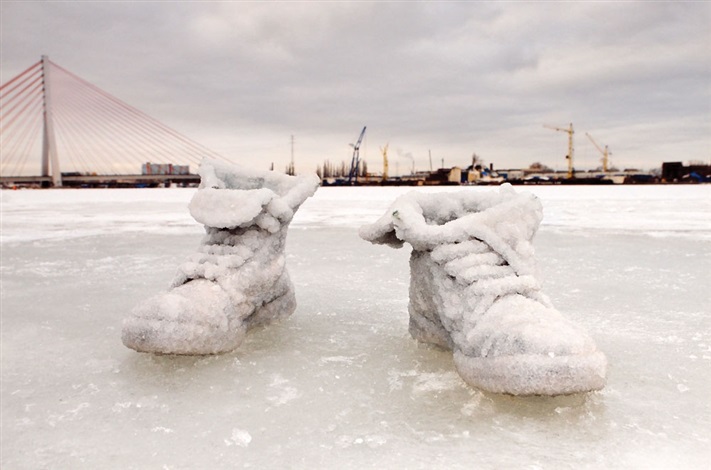
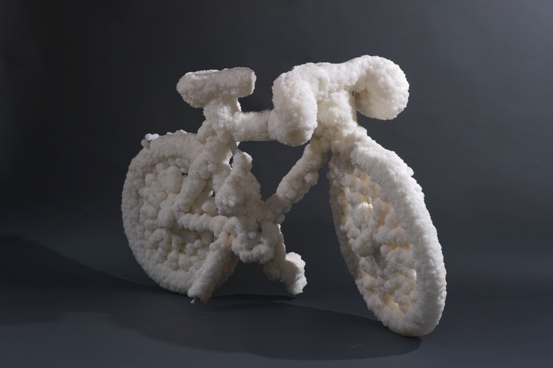
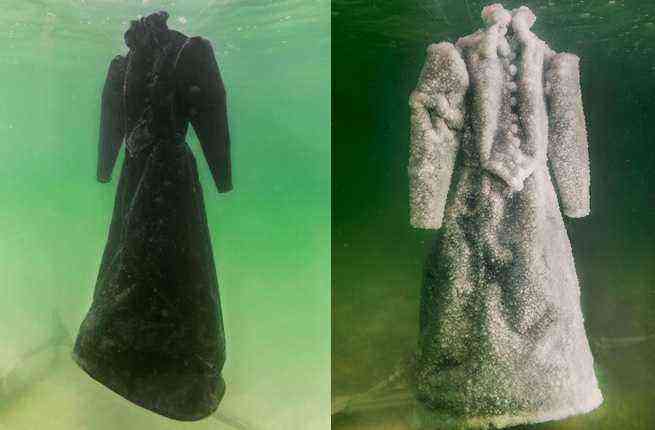
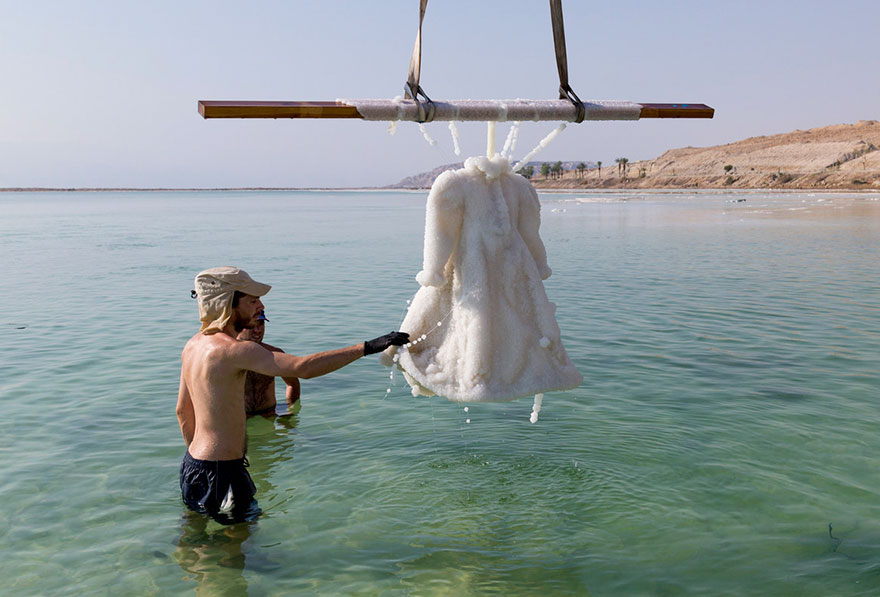
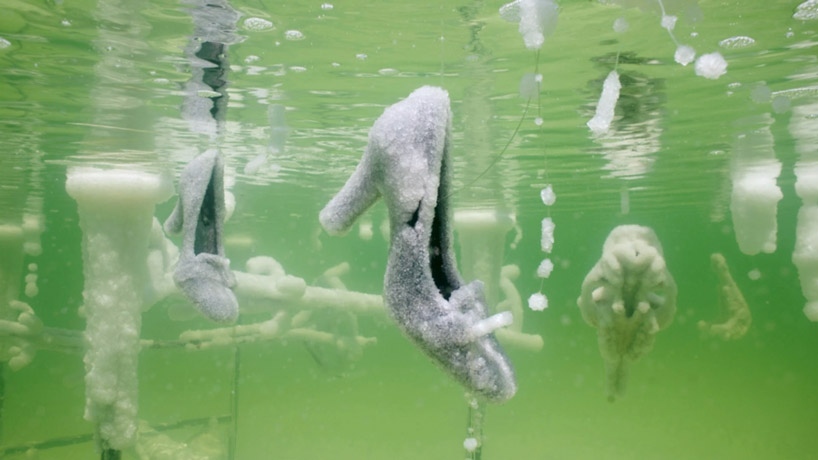
Sigalit Landeau a victorian dress in the dead sea for 2 months and it came out completely solid and crystallised. I was interested by the fact that she used an object that is decaying or will decay metaphorically and physically as victorian dress are no more the fashion of the day, and the material is decaying too.
Sigalit Landeau
Ice lollies

I was interested by this ice lollies work, It shows the pollution of water and it is "frost". It is inspiring for my work as I talk about everlasting decay, the decay of a soda can takes 500 years, and these lolies frost the decaying time. It is a very powerful art work.
Andreas Gursky
This is a press release from the gursky exhibition. I love how he talks about his work the Rhine II.
He offers a neatly controlled version of the natural world. The grass has been "manicured". He clearly conveys his strong opinion here about the impact of our society on environnement.
Much like i'm exploring, gursky talks about the eternal conflict between us and nature. This everlasting battle is a domination conflict. Humans want to dominate the world and nature.
Gursky Exhibition
These photographs shows the human impact on nature. Clean minimalistic landscapes, overconsumerism, and urbanism.
Louise Nevelson

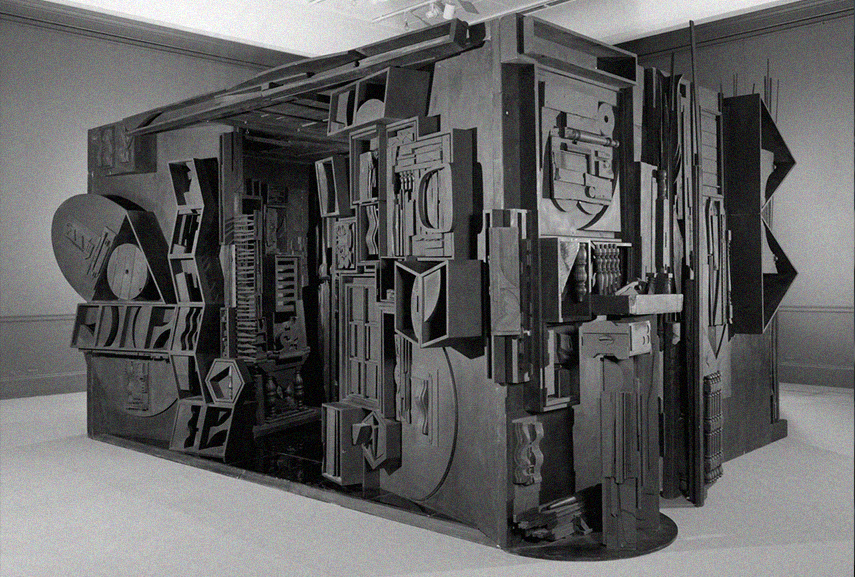

I went to see the work of Louise Nevelson part of the permanent exhibition at the Tate modern. I like how she separated her work into boxes, and it is a very interesting display for a "wunderkammer". Cabinet of curiosity, I would love to display all the items that any humans would wish to crystallise into different boxes and create a whole room or a whole wall. With different lightings underneath this could be very successfull.
I could display my barbies, on one side and have books in another box etc.
As I grow loose
Photographer Michael John Hunter manipulates scale perception in the most spectacular way. His images could – at first glance – appear to be normal objects in model environments, but look closer and they are in fact enormous sculptures in real-life locations. Inspired by hyperreal sculpture, miniature art and artists like Ron Mueck, Lori Nix and Slinkachu, Michael has made giant models of a Barbie and a mammoth bluebottle, and photographed them in various London streets and countryside.
It all started when he studied Fine Art Photography eight years ago. “I was obsessed with large format film cameras and the way you could skew focus with them,” he says. “I use these old cameras that have an ability to make the focus seem unnatural and allow me to trick the viewer. It’s basically ‘tilt shift’ photography done in-camera, not post. I guess I’m interested in purism in art, I like traditional techniques.”
Since Michael left art school, he always had these ideas in the back of his mind, but explains he neither had the skills as a sculptor nor the funds to make them happen. He found his way to a career in the film industry, and in the background saved money to make his personal work. “I knew that to undertake such projects and pull them off, the sculptures had to be flawless. The illusions would only work if the viewer believed they were real-sized objects.”
The sculptures are photographed at night, from a certain height and angle and using a specific focus technique that Michael says “fakes macro photography”. “People tend to think it’s a small set around a normal object, but when you give the viewer the information they’re able to reassess the image with totally virgin eyes. As a child I had toys and model sets that mimicked a grown-up reality, and this was full of fantasy and endless possibility. As an adult we lose a lot of this amazement – this is where my work starts. It’s about deception and illusion, the sense of wonder and possibility we felt as children.
As I grow, as I lose is Michael’s most recent piece, featuring a 20ft doll. “Logistics are a nightmare – I’m just a dude in a van doing this with a friend in the middle of the night. And it’s financially ruined me! But staying true to something I believed in so long ago has made me happy.”
Michael John Hunter

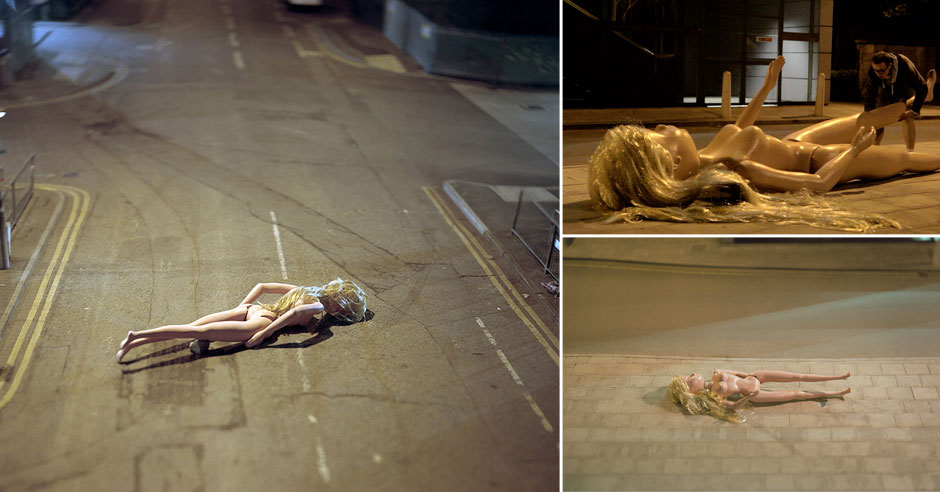
This set of work is very useful. I really like the fact that the artist created huge barbies and photographed them so they appear small. I will try to use this technique in furether work, it is interesting to play with the means of photography with the illusion. Somehow, i find that my photograph of my barbies "failure" works are quite similar.
Here, Michael John Hunter plays with our brain, because we immediately visualize barbies or flies (other series of work) as small objects so when we see the picture we immediately think that the artist photographed these small object. It is just when we see the pictures with a human next to it, that our mind does a jump.
Clara Maciàs Performance
She lay in between barbies to make a point about society icons. And our will to preserve and try to reach that size
Eyeballs

This is inspiring, i want to make some clay modelling and preserve all the humans perfect features into liquids. There are halloween videos where you learn how to put the eyeballs in clay modelling in resin.
Statistic breast surgeries
ARLINGTON HEIGHTS, IL – New data released by the American Society of Plastic Surgeons (ASPS) show continued growth in cosmetic procedures over the last year, and a shift in the types of procedures patients have chosen since the start of the new millennium. According to the annual plastic surgery procedural statistics, there were 15.9 million surgical and minimally-invasive cosmetic procedures performed in the United States in 2015, a 2 percent increase over 2014.
Since 2000, overall procedures have risen 115 percent, but the types of procedures patients are choosing are changing.
"While more traditional facial procedures and breast augmentations are still among the most popular, we're seeing much more diversity in the areas of the body patients are choosing to address," said ASPS President David H. Song, MD, MBA, FACS. "Patients have more options than ever, and working closely with their surgeon, they're able to focus on specific target areas of the body to achieve the look they desire."
Lifts Lead the List
It used to be that the term plastic surgery was nearly synonymous with facelifts, and while they remain a popular option among patients, other types of lifts are surging.
Since 2000, ASPS statistics show considerable growth in:
- Breast lifts, up 89 percent (99,614 in 2015, up from 52,836 in 2000)
- Buttock lifts, up 252 percent (4,767 in 2015, up from 1,356 in 2000)
- Lower body lifts, up 3,973 percent (8,431 in 2015, up from 207 in 2000)
- Upper arm lifts, up 4,959 percent (17,099 in 2015, up from 338 in 2000)
Top 5 Cosmetic Surgical and Minimally-Invasive Procedures
While procedures like upper arm lifts and lower body lifts have shown substantial growth, for the first time since at least 2000, facelifts slipped out of the top 5 most-performed procedures last year, giving way to tummy tucks.
Of the 1.7 million cosmetic surgical procedures performed in 2015, the top 5 were:
- Breast augmentation (279,143 procedures, down 2 percent from 2014, up 31 percent from 2000)
- Liposuction (222,051 procedures, up 5% from 2014 but down 37 percent from 2000)
- Nose reshaping (217,979 procedures, unchanged from 2014, down 44 percent since 2000)
- Eyelid surgery (203,934 procedures, down 1 percent from 2014, down 38 percent since 2000)
- Tummy tuck (127,967 procedures, up 9 percent from 2014 and 104 percent since 2000)
Painting Anonymous

Interesting drawing of fading beauty, I was inspired by this to do some drawings, for me i could really see this women fading away like her beauty is overtime. We cling to beauty so much nowadays, and we do not accept to let it ago/ aging.
Article by David Oliver
- Old people takes up the places of the young in needs, and never leave the hospital. This is once again something completely not natural. We want, to keep those who must go the longest, we fight for their lives by the new means of science. Rather than letting, the natural process happen,we live, die decay, we try defying the laws of nature.Worlds records rises up to 122, thanks to science, and you can now almost live with a mechanical heart. "Transhuman". Jacques Attali in his book 2050 predicts that by this date we'll all be centenary meaning that 50% will be over the age of 60, meaning that the world will be govern by the old.
Discharging older patients from hospital, the National Audit Office (NAO) report published today, focuses primarily on those patients deemed ‘medically fit for discharge’ but who are stranded in hospital.
The NAO report looks beyond the official data on delayed transfers of care at the underlying issues affecting this group of patients.
Between 2013 and 2015, official delayed transfers of care rose 31 per cent and in 2015 accounted for 1.15 million bed days – 85 per cent of patients occupying these beds were aged over 65. The NAO estimates that the real number of delays is around 2.7 times higher than those officially counted. No wonder delayed discharges topped the list of concerns reported by NHS finance directors in The King’s Fund’s latest Quarterly Monitoring Report.
Waiting for social care was the biggest cause of this sharp rise. Since 2010, waits for home care packages have doubled and waits for beds in nursing homes increased by 63 per cent. This isn’t surprising given the increasing number of old, frail and medically complex hospital patients, coupled with 10 per cent cuts in real-terms funding for social care over the past five years. The Barker Commission warned of the potential impact on the NHS of inadequate social care funding and the anomaly between free-at-point-of-use health care versus means-tested and highly rationed social care.
But it’s not just social care. The NHS Benchmarking national audit of intermediate care estimates that we only have around half the intermediate care places we need nationally, and that average waits for home care rehabilitation and re-ablement are now eight and six days respectively. And as money gets tighter, delays caused by waiting for decisions on NHS-funded continuing care are increasingly problematic.
The NAO’s conclusions on cost are particularly interesting: it estimates that the current cost of delays to the hospital sector is £820 million per annum, compared to a hypothetical cost of alternative community services for all those patients of just £180 million. This potential saving is a scenario based on all those delays being remedied, and requiring activity or capacity to be taken out of acute beds at a time when they are pressurised. Recent history would suggest caution in making such projections.
So what’s the solution? The NAO makes a series of recommendations, but here I will make some suggestions of my own. Let’s take the need for adequate funding capacity for both social care and community health services for granted. These are usually the same services that can support people outside hospital and prevent admissions in the first place. For instance, the intermediate care audit has shown that rapid response teams providing ‘wrap around’ services in people’s own homes can prevent hospital admissions in precisely the group of patients most likely to end up delayed. Several examples of this integrated care approach were showcased at our conference earlier this year and in our 2014 report.
Some delays are simply down to poor collaboration, poor information-sharing and clunky procedures at the interfaces between hospitals and local partners. Mistrust between professionals can also be an issue. Or even worse, current financial constraints mean that it may be in their interests to introduce delays in order to delay spending. Trusts such as Sandwell have reduced delays by moving towards one point of access, telephone referral, single trusted assessment and one team.
Finally, it’s important that acute hospitals also deliver solutions, for example, by addressing variability in bed occupancy, minimising internal delays for investigation or treatment and repeated ward moves. Senior decision-makers and specialist teams at the hospital door; rapid access ambulatory care clinics; specialist frailty assessment units; and a relentless focus on rehabilitation, discharge planning, senior review and real-time use of data on delays can help to reduce bed occupancy and get more patients straight back home on being declared medically fit for discharge. Hospitals can also reduce the need for step-down services by maximising patients’ independence. Case studies from Sheffield and Warwickshire have shown what can be done. The NAO and NHS Benchmarking reports have shown that a growing number of hospitals have embraced these approaches but their application is still variable.
With a mounting acute provider sector deficit of £2.45 billion and £8.7 billion more savings to come, concerted action on delayed transfers of care is essential to avoid worsening performance on meeting urgent care targets. But most of all delays impose a huge human cost on real people with real families and real concerns marooned in hospital. How easily we can lose sight of this.
Cabinet of curiosity






Cabinets of curiosity are fascinating, I think I would like to create a cabinet of curiosity of all the things human wanted to preserve. It could be a mental cabinet of curiosity for example all of the immaterial things such as love, and memories would be objects and occupy one space of the cabinet.
I really like the way that a mixture between ancient animals and plants as well as old books are mixed. I could take my entire audience on a trip towards all the little things that i wish would never age and die.
Damien Hirst


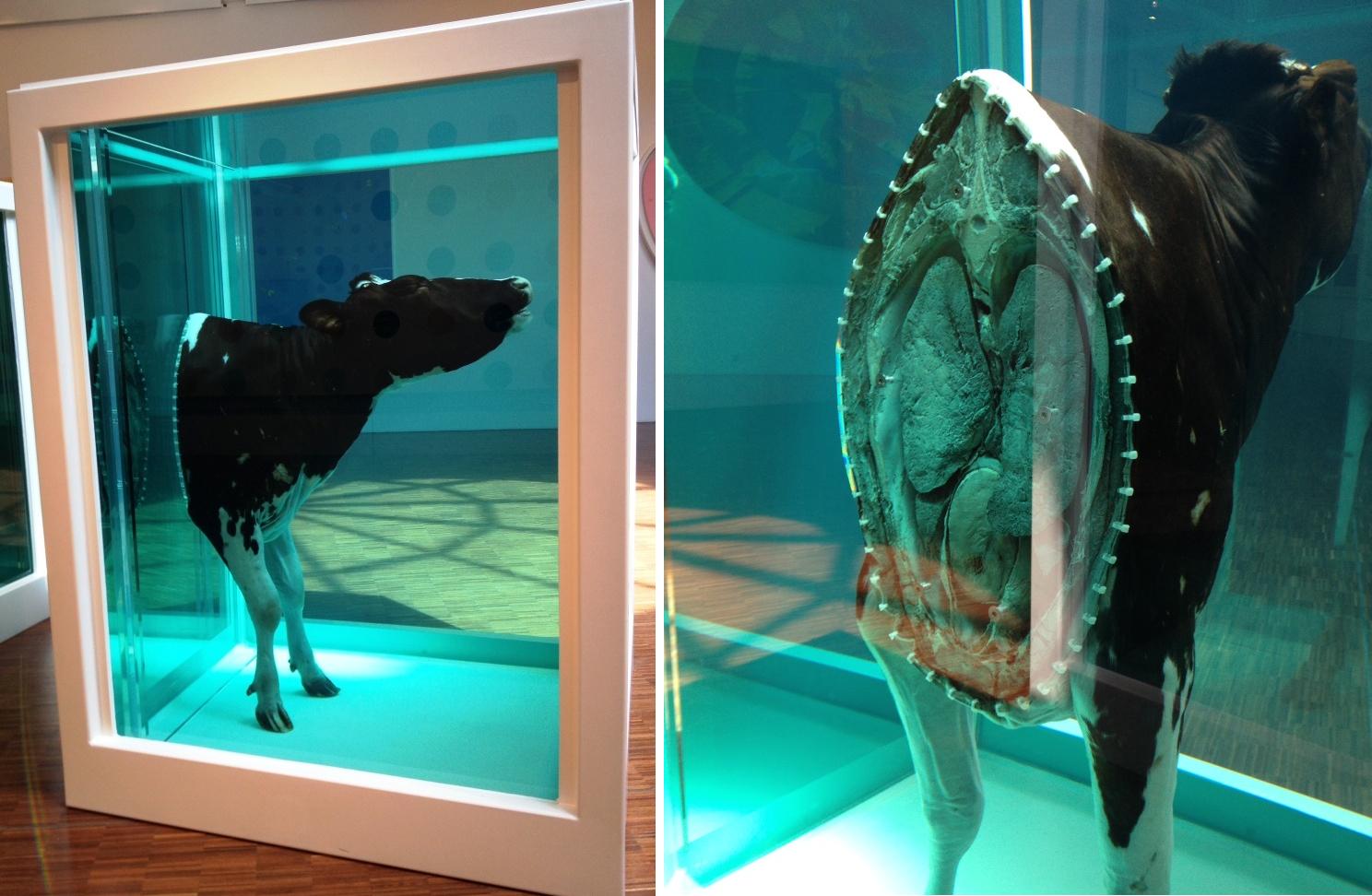
Damien Hirst work of putting murdered and than animals meant to decay in the formol is a method of preservation. My idea is everlasting decay, much like Tyler Thrasher Damien Hirst defies the laws of nature in prolongating the decaying phase. Since i am verry interested in cabinet of curiosity this is inspiring for my work, i've created those clay figurines and could try putting them in the same material to make it look undecayable. Or similarly, i could use real life animal such as fish/ chicken and put them in that.
Demain Movie
Analysis of 2050
Here the book 2050 by Jacques Attali, a French philosopher, makes prediction about our future.
Even though our world has the potential for the best, it also has the potential for the worst.
We have a choice, depending on our actions, our children and grand children have the potential to live in a viable word and exciting, or can go through a nightmare and will hate us.
Translation of the highlited bits: In 2050 9,2 billion people will live on earth, so 2 billion more than today. Life expectancy will reach the century. As a result, the age of humanity will be much higher.
Two thirds of the planet will live in cities where the population will have doubled, and Two Thirds of childrens born in 2050 will live in the 20 poorest countries.



